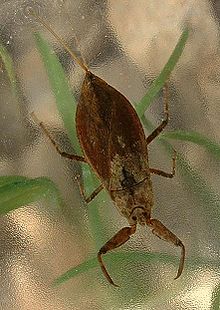You can help expand this article with text translated from the corresponding article in German. (July 2019) Click for important translation instructions.
|
| Nepa cinerea | |
|---|---|

| |
| Scientific classification | |
| Domain: | Eukaryota |
| Kingdom: | Animalia |
| Phylum: | Arthropoda |
| Class: | Insecta |
| Order: | Hemiptera |
| Suborder: | Heteroptera |
| Family: | Nepidae |
| Subfamily: | Nepinae |
| Genus: | Nepa |
| Species: | N. cinerea |
| Binomial name | |
| Nepa cinerea Linnaeus, 1758 | |
Nepa cinerea is a species of water scorpion (Nepidae), found in most of Europe, including the British Isles, as well as North Africa and southern and northern Asia.
Habitat and Biology
It lives in ponds, small rivers, and stagnant water, and feeds upon aquatic animals, especially insects.
Respiration in the adult is effected by means of the caudal process, which consists of a pair of half-tubes capable of being locked together to form a siphon by means of which air is conducted to the tracheae at the apex of the abdomen when the tip of the tube is thrust above the surface of the water. In immature forms, the siphon is undeveloped and breathing takes place through six pairs of abdominal spiracles. The eggs, laid in the stems of plants, are supplied with seven filamentous processes which float freely in the water.
References
- "Nepa cinerea". The Encyclopedia of Life.
- S.L. Keffer; J.T. Polhemus; J.E. McPherson (1990). "What Is Nepa hoffmanni (Heteroptera: Nepidae)? Male Genitalia Hold the Answer, and Delimit Species Groups". Journal of the New York Entomological Society. 98 (2): 154–162.
External links
 Media related to Nepa cinerea at Wikimedia Commons
Media related to Nepa cinerea at Wikimedia Commons Data related to Nepa cinerea at Wikispecies
Data related to Nepa cinerea at Wikispecies